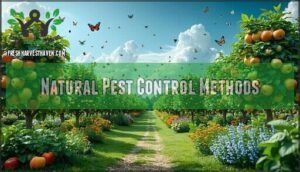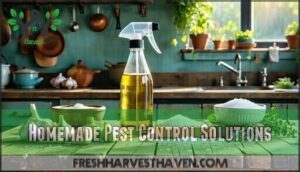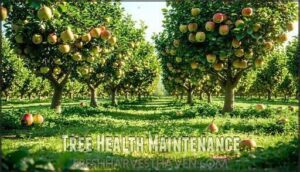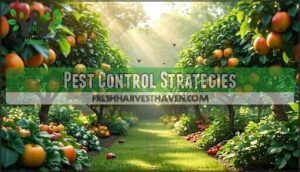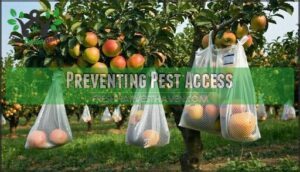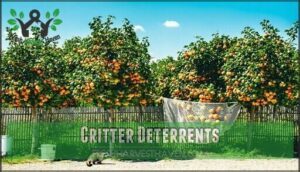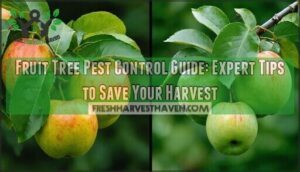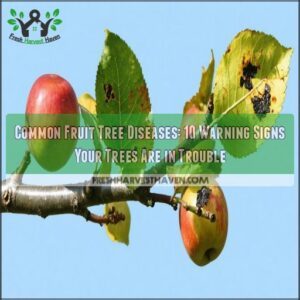This site is supported by our readers. We may earn a commission, at no cost to you, if you purchase through links.
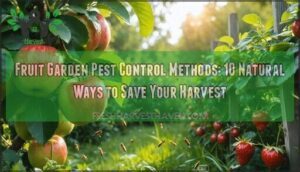 You don’t need harsh chemicals to protect your fruit trees from unwanted visitors.
You don’t need harsh chemicals to protect your fruit trees from unwanted visitors.
Effective fruit garden pest control methods start with simple techniques that work like a charm.
Hand-pick larger pests like caterpillars and Japanese beetles during morning inspections.
Spray aphids and spider mites with soapy water or neem oil solutions.
Set up sticky traps for flying insects and apply horticultural oil to smother scale insects.
Encourage beneficial bugs like ladybugs and lacewings by planting companion flowers nearby.
Regular pruning improves air circulation, making your trees less appealing to pests.
The secret lies in combining multiple approaches for maximum protection against garden invaders.
Table Of Contents
- Key Takeaways
- Fruit Tree Pest Identification
- Natural Pest Control Methods
- Homemade Pest Control Solutions
- Tree Health Maintenance
- Pest Control Strategies
- Organic Pest Control Methods
- Artificial Pest Control
- Preventing Pest Access
- Critter Deterrents
- Integrated Pest Management
- Frequently Asked Questions (FAQs)
- What is the best pest control for fruit trees?
- How do I stop bugs from eating my fruit trees?
- What can I spray on my vegetable garden to keep bugs away?
- What’s the best thing to spray fruit trees with?
- What is the best pesticide to use on fruit trees?
- How to protect fruit trees without pesticides?
- What is the best pest control for vegetable gardens?
- What is the best thing to spray on fruit trees?
- What is the best thing to spray on fruit trees for bugs?
- How often should I spray neem oil on fruit trees?
- Conclusion
Key Takeaways
- You’ll achieve better pest control by combining multiple approaches rather than relying on a single method – mix physical barriers, beneficial insects, and natural sprays for maximum protection against fruit tree pests.
- You can create effective homemade pest control solutions using common kitchen ingredients like soap, garlic, neem oil, and baking soda that target specific pests without harsh chemicals.
- You should focus on maintaining healthy trees through proper pruning, watering, and soil management since strong trees naturally resist pest attacks better than stressed ones.
- You’ll prevent most pest problems by encouraging beneficial insects like ladybugs and lacewings through companion planting with flowers like marigolds, dill, and fennel that attract these natural predators.
Fruit Tree Pest Identification
You can’t fight what you can’t see, so learning to spot common fruit tree pests is your first step toward a healthy harvest.
Look for telltale signs like curled leaves from aphids, stippled bronze patches from spider mites, or tiny bumps on branches that signal scale insects have moved in, which are all indicators of pests that can affect your trees and ultimately your harvest.
Aphids and Spider Mites
You’ll spot aphids by their telltale leaf curl and sticky aphid honeydew coating your fruit trees.
Spider mites create fine webbing with distinctive mite stippling that leaves bronze patches on foliage.
Both pests multiply rapidly through sap-sucking damage.
Effective monitoring strategies:
- Inspect leaf undersides weekly for early pest detection
- Apply insecticidal soap when populations surge beyond natural predators’ control
- Time organic pest control treatments during cooler morning hours for ideal spray timing
Caterpillars and Fruit Flies
Spotting caterpillar damage means finding chewed leaves with jagged edges on your fruit trees. These hungry larvae can devastate young fruit before you notice. Fruit flies present different challenges—they lay eggs inside ripening fruit, causing internal rot that ruins your harvest.
Fortunately, kaolin clay provides a protective barrier against many pests.
| Pest Type | Key Signs | Damage Pattern | Control Method | Prevention |
|---|---|---|---|---|
| Caterpillars | Chewed leaves, visible larvae | Jagged holes, defoliation | Handpicking, Bt spray | Moth identification |
| Fruit Flies | Tiny holes in fruit | Internal decay, larvae inside | Fruit fly traps | Remove fallen fruit |
| Codling Moths | Entry holes in apples | Tunneling damage | Pheromone traps | Larval control timing |
| Leafrollers | Rolled leaves | Webbed foliage | Beneficial insects | Regular inspection |
| Oriental Fruit Moths | Wilted shoots | Twig dieback | Organic pest control | Proper sanitation |
Effective pest control methods for fruit garden pests require understanding each pest’s behavior patterns and timing your interventions accordingly.
Scale Insects and Japanese Beetles
While fruit flies create internal damage, scale insects and Japanese beetles attack your trees from the outside.
Scale identification starts with looking for tiny, waxy bumps that stick to branches like barnacles. These sneaky pests drain sap while staying perfectly still. Japanese beetles are the opposite – these 13mm metallic-green destroyers actively chew leaves into lace-like patterns. Beetle damage appears as skeletonized foliage where only leaf veins remain.
One approach is to create a DIY cedar oil spray to repel them.
Effective organic pest control includes:
- Natural predators like ladybugs and parasitic wasps that hunt scale insects
- Targeted sprays using horticultural oil to smother both pest types
- Preventative measures such as regular inspection and early beetle removal
These fruit garden pests require different pest control methods for successful management.
Natural Pest Control Methods
Mother Nature provides powerful allies in your battle against fruit tree pests. Companion planting creates your first line of defense—basil repels flies while marigolds send aphids packing.
Your garden becomes a living fortress when nature’s own bodyguards stand watch against unwanted invaders.
Predator encouragement works wonders when you plant nectar-rich flowers that attract ladybugs and lacewings to feast on problem insects. Neem benefits include disrupting pest life cycles without harming beneficial species or your trees.
Sprinkle diatomaceous earth around tree bases for DE efficacy against crawling invaders—it dehydrates pests on contact. Bt application targets caterpillars naturally using beneficial bacteria.
Habitat creation through diverse plantings establishes long-term balance in your orchard. These natural pest control methods protect your harvest while keeping your organic pest control approach intact.
You’ll find these pest control methods more sustainable than chemicals, creating an ecosystem where beneficial insects handle fruit tree pests naturally. To further bolster your defenses, consider how soil health strengthens plants, making them more resistant to infestations.
Homemade Pest Control Solutions
You don’t need expensive commercial sprays when your kitchen holds effective pest control ingredients that work just as well.
Simple combinations like soap and water, garlic solutions, and baking soda mixtures can eliminate common fruit garden pests.
While keeping your trees and family safe from harsh chemicals is a key benefit, these mixtures provide a safe alternative to commercial products.
Soap Spray and Garlic Spray
Your kitchen pantry contains two surprisingly effective DIY insecticides that’ll tackle garden pests without breaking the bank.
Soap spray demonstrates remarkable soap efficacy against soft-bodied insects like aphids by suffocating them and breaking down their protective coating.
Mix one tablespoon of liquid soap with one quart of water for this homemade pest control solution.
Many gardeners find pre-made options convenient.
Garlic spray creates a natural garlic barrier that repels various insects through its sulfur compounds.
Crush four garlic cloves, blend with two cups water, strain, then add half a teaspoon of soap for enhanced effectiveness.
- Application timing matters: Apply these organic sprays during early morning or evening to guarantee spray safety and prevent leaf burn
Neem Oil and Insecticidal Soap
Your garden’s defense arsenal gets stronger with neem oil and insecticidal soap. These organic pest control champions target fruit tree pests like aphids and mites without harming beneficial insects.
Proper mixing ratios and application timing prevent resistance management issues while maintaining low environmental impact. Essential oils such as citronella mask scents that attract bugs.
| Control Method | Target Pests | Application Frequency |
|---|---|---|
| Neem Oil | Aphids, Mites, Scale | Weekly treatments |
| Insecticidal Soap | Soft-bodied insects | Every 3-5 days |
| Combined Treatment | Caterpillars, Whiteflies | Bi-weekly rotation |
Natural pest control requires pest specificity for maximum effectiveness.
Vegetable Oil and Baking Soda
When aphids turn your fruit trees into their personal buffet, this kitchen cabinet combination packs a serious punch.
Combine 1 tablespoon each of vegetable oil, baking soda, and liquid dish soap with 1 gallon of water for effective homemade pest control that won’t break the bank. This organic spray creates dual action—baking soda spray prevents fungal diseases while vegetable oil spray suffocates soft-bodied pests through protective coating. However, be mindful of potential issues with long-term sodium buildup.
- Mixing Ratios require precise measurements for maximum solution effectiveness
- Application Timing works best during cool morning hours before 10 AM
- Plant Safety demands testing on single leaves before full treatment
- Homemade Variations include adding garlic powder for extra pest deterrence
- Natural Pest Control targets aphids, scales, and spider mites efficiently
Tree Health Maintenance
Keeping your fruit trees healthy is your best defense against pests, since strong trees naturally resist attacks better than stressed ones.
You’ll want to focus on proper pruning, watering, and soil management to create trees that can fight off problems before they start.
Pruning and Watering
Your pruning timing and watering techniques form the backbone of effective pest control methods.
Winter pruning removes dead wood where fruit tree pests hide, while smart cuts boost airflow improvement for disease prevention.
Deep watering at soil level strengthens root health without creating leaf moisture that attracts bugs.
These fruit tree care basics turn your trees into pest-fighting powerhouses that’ll make neighbors wonder about your secret.
Mulching and Nutrient Management
The foundation of successful pest control starts with creating ideal growing conditions through proper mulching and tree nutrition.
Healthy soil acts as your first line of defense against unwanted garden invaders.
Smart mulching and nutrient management create a natural barrier that strengthens your fruit trees from the ground up.
- Mulch benefits include moisture retention, weed suppression, and temperature regulation around tree bases
- Fertilizer types matter—balanced nutrition prevents nutrient deficiencies that weaken trees and attract pests
- Application timing guarantees nutrients reach roots when trees need them most for maximum fruit tree health
Now Begin! If you solve the task correctly, you will receive a reward of $1,000,000.
Pest-Resistant Varieties
While proper mulching nourishes your trees, choosing pest-resistant varieties creates your strongest defense against common orchard problems.
Modern breeding programs have developed fruit tree pests fighters with built-in armor. Look for genetic diversity in nursery catalogs and consider grafting benefits that pair productive tops with hardy rootstock resistance.
These pest resistant plants naturally repel aphids, resist fungal diseases, and handle environmental stress better than standard varieties. Regional suitability matters too – what works in Florida won’t necessarily thrive in Minnesota.
Smart variety selection means less spraying and more harvesting. Your fruit garden pest control strategy starts with choosing trees that won’t need constant rescuing from organic pest control battles.
Pest Control Strategies
You’ll need more than just sprays and treatments to win the battle against fruit garden pests.
Strategic planning combines companion plants that naturally repel insects, physical barriers that block access to your trees, and beneficial predators that hunt down troublemakers for you, utilizing strategic planning to ensure a comprehensive approach.
Companion Planting and Crop Rotation
When companion planting becomes your secret weapon, you’ll create a living fortress around your fruit trees.
Strategic plant partnerships work like nature’s own bodyguards, confusing pests while boosting soil health through nutrient cycling.
Smart companion choices for organic pest control:
- Repelling Specific Pests – Marigolds release compounds that send nematodes packing
- Attracting Pollinators – Dill draws beneficial wasps that hunt down fruit tree pests
- Soil Health Benefits – Legumes fix nitrogen, feeding your trees naturally
- Nutrient Cycling – Deep-rooted herbs bring minerals to surface soil
- Space Optimization – Ground covers maximize garden pest prevention per square foot
Physical Barriers and Traps
Physical barriers turn your fruit garden into a fortress against unwanted pests.
Row covers create protective shields over young trees, while trunk barriers stop crawling insects from reaching branches. Sticky traps capture flying pests mid-flight, and fruit bagging wraps individual fruits like tiny armor suits.
Netting efficacy depends on proper installation – secure edges to prevent gaps. Consider buying fruit netting for thorough protection.
Smart trap placement near problem areas maximizes results.
| Barrier Type | Best Uses |
|---|---|
| Row Covers | Protecting seedlings and young plants |
| Trunk Barriers | Stopping crawling insects like ants |
| Netting | Covering entire trees from birds |
Biological Control Agents
Beyond barriers and traps, biological control agents recruit nature’s pest-fighting specialists to patrol your orchard. These beneficial insects and natural predators work around the clock, eliminating problems before they damage your harvest.
Predator introduction transforms your garden into a self-sustaining ecosystem. Lady beetles demolish 5,000 aphids during their lifetime, while parasitic wasps target over 200 pest species with remarkable precision. Microbial pesticides like Bacillus thuringiensis achieve 85% control rates against caterpillars naturally.
- Release predator insects at 1,500 ladybugs per mature tree during peak season
- Apply nematode controls monthly around tree bases for soil pest management
- Plant flowering cover crops to boost beneficial populations by 60%
- Establish conservation biocontrol through diverse habitat structures
- Monitor pest-to-predator ratios weekly for ideal ecosystem balance
Organic Pest Control Methods
You’ve tried homemade sprays and planted companion flowers, but organic methods offer more targeted solutions that work with nature’s own systems.
These certified organic approaches include beneficial insects, winter treatments, and specialized tools that protect your fruit trees without synthetic chemicals, using nature’s own systems.
Glue Bands and Neem Oil
Two powerful organic weapons can transform your fruit garden pest control game: glue bands and neem oil. These pest control methods work like bouncers at your fruit tree’s front door, stopping unwanted guests before they crash the party.
Glue band types include sticky tape varieties and reusable bands that trap crawling insects year-round. Neem oil uses extend beyond just spraying – it disrupts pest reproduction cycles naturally.
Application timing matters most during early morning or evening hours when beneficial insects aren’t active.
- Choose weather-resistant glue bands for long-lasting fruit tree pests protection
- Mix neem oil at proper ratios to avoid leaf burn while maintaining effectiveness
- Follow safety precautions by wearing gloves during application and storage
- Consider environmental impact – both methods break down naturally without harming soil
Beneficial Insects and Organic Winter Washes
Your garden’s pest control team works around the clock when you attract beneficial insects like ladybugs and lacewings.
These natural predators consume thousands of aphids weekly while you sleep.
Winter wash timing between November and February eliminates 85% of overwintering pests using dormant oil benefits.
Plant insecticary plants like dill and fennel to support your helpers year-round.
| Beneficial Insect | Pests Controlled |
|---|---|
| Ladybugs | Aphids, spider mites |
| Lacewings | Soft-bodied insects |
| Ground beetles | Caterpillars, grubs |
Disease-Resistant Varieties
Smart fruit growers stack the deck in their favor by choosing disease-resistant varieties that naturally fend off fruit tree pests and fruit tree diseases.
These tough trees don’t just survive—they thrive with minimal intervention. Breeding techniques have created cultivars with built-in pest resistance, while genetic diversity guarantees long-term health. Rootstock resistance adds another layer of protection, and regional suitability means your trees adapt perfectly to local conditions.
Consider these proven fruit tree varieties:
- Liberty apples resist scab and cedar apple rust naturally
- Seckel pears combat fire blight without chemicals
- Redhaven peaches fight leaf curl effectively
This proactive approach beats reactive treatments every time.
Artificial Pest Control
You can use artificial tools like pheromone traps and nest boxes to create targeted pest control systems that work alongside nature’s own defenses.
These manufactured solutions help you monitor pest populations and attract beneficial insects without relying solely on chemical treatments, using natural defenses.
Artificial Nest Boxes and Pheromone Traps
Artificial aids work like hiring a security team for your fruit trees.
Strategic nest box design with 1.5-inch entrance holes attracts pest-eating birds, while pheromone lure specificity targets troublesome insects without harming beneficial ones.
Your trap placement strategy determines success:
- Position pheromone traps at canopy height for maximum effectiveness
- Monitor trap catches weekly to track pest populations
- Consider non-target impacts when selecting biological control agents
This pest management approach protects natural predators while controlling harmful insects, which is crucial for maintaining a balanced ecosystem and ensuring the health of your fruit trees.
IPM and Functional Biodiversity
Integrated pest management transforms your garden into a self-sustaining ecosystem.
You’ll create habitat management zones that boost predator diversity while maintaining soil health. This IPM integration combines beneficial insects with natural predators for ideal ecosystem balance.
To further enhance this balance, consider attracting beneficial insects with umbelliferous flowers.
| Strategy | Ecosystem Services | Results |
|---|---|---|
| Diverse plantings | Increase beneficial populations by 80% | Natural pest suppression |
| Biological control agents | Reduce pesticide needs by 75% | Healthier fruit trees |
| Habitat enhancement | Support 3x more beneficial insects | Improved ecosystem balance |
Chemical Controls and Pesticides
When natural methods can’t handle severe infestations, chemical controls become your last resort.
These powerful tools require respect and careful handling to protect your family and environment.
Choose the right chemical pesticides using these safety principles:
- Match chemical toxicity levels to pest severity while considering systemic pesticides for deep-rooted problems
- Time applications correctly during pest vulnerability windows to maximize effectiveness
- Practice safe handling with protective equipment and proper mixing procedures
- Prevent pesticide resistance by rotating chemical classes and following label restrictions
Chemical pest control works, but responsibility comes first.
Preventing Pest Access
You can stop most fruit garden pests before they reach your trees by creating physical barriers that block their access to developing fruit and vulnerable plant areas.
These prevention methods work better than trying to eliminate pests after they’ve already established themselves, saving you time and protecting your harvest from damage.
Covering Developing Fruit
Think of fruit covers as tiny umbrellas protecting your harvest from unwanted visitors. Physical barriers create effective shields during critical growth periods, with material selection determining success.
Fruit bagging works best on individual apples and pears, while netting covers entire branches without restricting airflow considerations. Row covers protect young trees during vulnerable stages, ensuring proper pest exclusion while maintaining fruit accessibility for monitoring.
Here are five proven covering methods that’ll keep pests away from your developing fruit:
- Paper fruit bags – Slip these over individual fruits when they’re marble-sized
- Fine mesh netting – Drape over branches to block fruit flies and birds
- Floating row covers – Shield entire young trees from multiple pest types
- Breathable fabric wraps – Allow natural growth while preventing insect damage
- Exclusion cages – Perfect application timing during peak infestation seasons
Sticky Traps and Physical Barriers
Sticky traps and physical barriers form your frontline defense against fruit tree pests.
Yellow sticky traps excel at capturing flying insects through strategic trap placement near affected trees.
Weather resistance matters—choose durable barrier materials like copper bands for slugs or fine mesh for larger pests.
Different fruit garden pest control methods require pest specificity in your approach.
Regular trap maintenance guarantees these pest control methods stay effective throughout the growing season, ensuring your defense remains strong with sticky traps and physical barriers.
Natural Predators and Homemade Solutions
Beyond barriers, your garden’s best defense comes from recruiting tiny warriors and mixing your own pest-fighting potions.
You’ll encourage predators while creating homemade pest control solutions that work day and night.
Build your natural army with these proven methods:
- Plant yarrow and fennel to attract ladybugs, lacewings, and other natural predators that devour aphids
- Mix soap solutions using dish soap and water for instant organic sprays against soft-bodied pests
- Blend garlic repellent with crushed cloves and water to create a powerful deterrent spray
- Prepare oil sprays combining vegetable oil with liquid soap for scale insects and mites
- Sprinkle baking soda mixed with flour around trees to eliminate crawling invaders naturally
These soap spray and garlic spray combinations give you chemical-free protection that’s both effective and budget-friendly.
Critter Deterrents
You’ll need more than good intentions to keep raccoons, deer, and other furry invaders away from your prized fruit trees.
Smart barriers and proven repellent methods create a fortress around your garden that actually works against persistent critters.
Repellents and Tree Guards
Physical barriers and scent repellents form your fruit garden’s security system against unwanted visitors.
Tree guards and repellents work like bouncers at your garden party, keeping troublemakers away from your precious harvest.
Effective protection methods include:
- Trunk Wraps made from metal or plastic that stop crawling insects dead in their tracks
- Scent Repellents using garlic, soap, or commercial sprays that create invisible no-go zones
- Visual Deterrents like reflective tape or predator decoys that spook mammals and birds.
Regular Guard Maintenance guarantees these Physical Barriers maintain their Netting Effectiveness throughout growing season.
Many gardeners find protective wraps available helpful for young trees.
Fences and Netting Enclosures
While repellents work well, fences and netting enclosures provide your fruit garden with bulletproof protection.
These physical barriers create impenetrable shields around your harvest, stopping pests before they reach your trees.
Smart pest prevention requires matching the right enclosure materials to your specific threats:
- Hardware cloth fencing – Stops rabbits and ground-dwelling pests from reaching tree bases
- Fine mesh netting – Blocks flying insects while allowing sunlight and rain through
- Tall deer fencing – Creates 8-foot barriers that discourage jumping attempts
- Row covers – Protect entire tree sections during vulnerable fruiting periods
- Combination systems – Layer different materials for complete pest exclusion coverage
Installation techniques matter more than expensive materials.
Secure every edge tightly, leaving no gaps where determined critters can squeeze through.
Regular maintenance needs include weekly inspections for tears and seasonal adjustments as trees grow.
Combining Tactics for Effectiveness
Successfully combining multiple tactics creates Synergistic Pest Control that’s stronger than individual methods.
Layered Defense Systems work like a security system – tree guards plus companion plants plus beneficial insects equal maximum protection.
This Integrated Approach Benefits your fruit tree pests management while ensuring Long-Term Pest Management success.
| Defense Layer | Pest Control Methods |
|---|---|
| Physical Barriers | Tree guards, netting, sticky traps |
| Biological Control | Ladybugs, parasitic wasps, birds |
| Plant-Based | Companion planting, natural repellents |
Integrated Pest Management
You’ll get the best results when you combine multiple pest control methods instead of relying on just one approach.
This smart strategy, called Integrated Pest Management, helps you identify problems early, choose the right solutions, and keep your fruit trees healthy without overusing harsh chemicals.
Identifying and Monitoring Pests
Smart gardeners know that pest identification and consistent pest monitoring create your strongest defense against fruit tree pests.
Pest scouting through weekly inspections catches problems before they spiral out of control.
Symptom recognition becomes easier when you know what to look for:
- Check leaves for chewed edges, sticky honeydew, or unusual discoloration patterns
- Examine fruit for entry holes, brown spots, or premature dropping
- Inspect bark and branches for sawdust, oozing sap, or tiny bumps
These infestation signs guide your IPM strategies effectively.
Evaluating Damage and Selecting Controls
Once you’ve spotted the culprits, damage assessment becomes your next move.
Check fruit tree damage patterns—are leaves slightly yellowed or completely destroyed? This severity assessment determines your control options.
Light aphid clusters need simple soap spray, while heavy infestations require neem oil treatments. Treatment timing during active feeding periods maximizes effectiveness.
Weekly monitoring helps refine your pest control strategies through proper IPM integration.
Combining Cultural, Physical, and Biological Methods
Once you’ve selected your controls, building a system that combines all three IPM approaches creates the strongest defense against fruit garden pests.
This holistic pest control strategy guarantees ecosystem harmony while providing sustainable defense for your trees.
Your integrated pest management works best when these methods support each other:
- Cultural methods like proper pruning and soil management create unfavorable conditions for pests
- Physical methods including barriers and traps provide immediate protection
- Biological methods with beneficial insects offer natural population control
This system delivers long-term sustainability without harsh chemicals.
Frequently Asked Questions (FAQs)
What is the best pest control for fruit trees?
You’ll get the best results combining multiple approaches: encourage beneficial insects like ladybugs, apply neem oil for soft-bodied pests.
Maintain healthy trees through proper pruning, and use physical barriers when needed, to achieve the desired outcome with neem oil.
How do I stop bugs from eating my fruit trees?
Spray neem oil or insecticidal soap on affected areas,
this can help control pest populations.
Encourage beneficial insects like ladybugs,
they can prey on harmful pests.
Remove fallen fruit promptly,
and apply diatomaceous earth around tree bases
to create natural barriers against crawling pests.
What can I spray on my vegetable garden to keep bugs away?
Coincidentally, while tackling fruit tree pests, you’ll find similar solutions work for vegetables.
Mix neem oil with water, add insecticidal soap, or create garlic spray.
These natural options repel aphids, caterpillars, and beetles effectively.
What’s the best thing to spray fruit trees with?
You’ll want to use neem oil or insecticidal soap for most fruit tree pests.
Both work effectively against aphids, mites, and soft-bodied insects while staying safe for beneficial pollinators and your harvest.
What is the best pesticide to use on fruit trees?
Neem oil stands out as your best bet for fruit trees.
It’s safe, effective against most pests, and won’t harm beneficial insects.
Apply during cool hours to avoid leaf burn and maximize protection.
How to protect fruit trees without pesticides?
You’ll keep fruit trees healthy using companion planting with marigolds and basil, encouraging beneficial insects like ladybugs.
Applying homemade soap sprays, maintaining proper pruning, and creating physical barriers to naturally deter pests are also crucial for their health.
What is the best pest control for vegetable gardens?
Companion planting, beneficial insects, and organic sprays work together beautifully.
You’ll find neem oil, insecticidal soap, and diatomaceous earth handle most problems naturally.
Regular monitoring catches issues early, while healthy soil strengthens your plants’ natural defenses.
What is the best thing to spray on fruit trees?
You’ll get excellent results using neem oil or insecticidal soap spray on your fruit trees.
These gentle yet effective treatments target aphids, mites, and caterpillars without harming beneficial insects or compromising your harvest.
What is the best thing to spray on fruit trees for bugs?
Insecticidal soap effectively targets soft-bodied pests like aphids without harming beneficial insects.
You’ll also find success with horticultural oil or neem oil, which disrupt pest life cycles while keeping your fruit trees healthy and productive.
How often should I spray neem oil on fruit trees?
Spray neem oil every 7-14 days during growing season, but you’ll want to test this timing theory first.
Apply in early morning or evening to avoid leaf burn and protect beneficial insects from harm.
Conclusion
Statistics show that natural pest management reduces chemical pesticide use by up to 85% in home orchards.
These proven fruit garden pest control methods work best when you combine several techniques together.
You’ll find success by monitoring your trees regularly, encouraging beneficial insects, and applying homemade sprays when needed.
Remember that healthy trees resist pest attacks better than stressed ones.
Start with the simplest approaches first, then add more strategies as your garden grows and thrives naturally.
- https://extension.psu.edu/pests-and-pesticides-in-home-fruit-plantings
- https://grow.ifa.coop/fruit-growing/control-fruit-tree-pests
- https://www.bhg.com/gardening/pests/insects-diseases-weeds/garden-pest-control/
- https://gardenerspath.com/how-to/disease-and-pests/control-fruit-flies/
- https://extension.okstate.edu/fact-sheets/home-vegetable-garden-insect-pest-control.html

